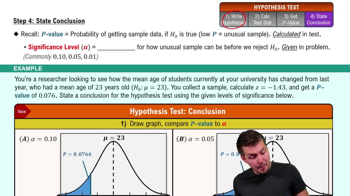In Exercise 1, you rejected the claim that p=0.53. But this claim was true. What type of error is this?
Table of contents
- 1. Intro to Stats and Collecting Data1h 14m
- 2. Describing Data with Tables and Graphs1h 55m
- 3. Describing Data Numerically2h 5m
- 4. Probability2h 16m
- 5. Binomial Distribution & Discrete Random Variables3h 6m
- 6. Normal Distribution and Continuous Random Variables2h 11m
- 7. Sampling Distributions & Confidence Intervals: Mean3h 23m
- Sampling Distribution of the Sample Mean and Central Limit Theorem19m
- Distribution of Sample Mean - Excel23m
- Introduction to Confidence Intervals15m
- Confidence Intervals for Population Mean1h 18m
- Determining the Minimum Sample Size Required12m
- Finding Probabilities and T Critical Values - Excel28m
- Confidence Intervals for Population Means - Excel25m
- 8. Sampling Distributions & Confidence Intervals: Proportion1h 25m
- 9. Hypothesis Testing for One Sample3h 57m
- 10. Hypothesis Testing for Two Samples4h 50m
- Two Proportions1h 13m
- Two Proportions Hypothesis Test - Excel28m
- Two Means - Unknown, Unequal Variance1h 3m
- Two Means - Unknown Variances Hypothesis Test - Excel12m
- Two Means - Unknown, Equal Variance15m
- Two Means - Unknown, Equal Variances Hypothesis Test - Excel9m
- Two Means - Known Variance12m
- Two Means - Sigma Known Hypothesis Test - Excel21m
- Two Means - Matched Pairs (Dependent Samples)42m
- Matched Pairs Hypothesis Test - Excel12m
- 11. Correlation1h 24m
- 12. Regression1h 50m
- 13. Chi-Square Tests & Goodness of Fit2h 21m
- 14. ANOVA1h 57m
9. Hypothesis Testing for One Sample
Steps in Hypothesis Testing
Problem 7.31
Textbook Question
In Exercises 29–34, find the critical value(s) and rejection region(s) for the type of t-test with level of significance α and sample size n.
Right-tailed test, α=0.02, n=63
 Verified step by step guidance
Verified step by step guidance1
Determine the degrees of freedom (df) for the t-test. The formula for degrees of freedom is df = n - 1, where n is the sample size. In this case, df = 63 - 1.
Identify the level of significance (α) for the test. Here, α = 0.02, which corresponds to the probability of rejecting the null hypothesis when it is true.
Since this is a right-tailed test, the critical value corresponds to the t-score where the area to the right under the t-distribution curve equals α. Use a t-distribution table or statistical software to find the t-score for df = 62 and α = 0.02.
Define the rejection region. For a right-tailed test, the rejection region consists of all t-scores greater than the critical value found in the previous step.
Summarize the results: The critical value and rejection region are determined based on the t-distribution table or software output. The rejection region is t > critical value.
 Verified video answer for a similar problem:
Verified video answer for a similar problem:This video solution was recommended by our tutors as helpful for the problem above
Video duration:
1mPlay a video:
Was this helpful?
Key Concepts
Here are the essential concepts you must grasp in order to answer the question correctly.
Critical Value
The critical value is a threshold that determines the boundary for rejecting the null hypothesis in hypothesis testing. It is derived from the chosen significance level (α) and the distribution of the test statistic. For a right-tailed t-test, the critical value is the point beyond which the null hypothesis is rejected, indicating that the observed data is statistically significant.
Recommended video:

Critical Values: t-Distribution
Rejection Region
The rejection region is the set of values for the test statistic that leads to the rejection of the null hypothesis. In a right-tailed t-test, this region is located to the right of the critical value on the t-distribution curve. If the calculated test statistic falls within this region, it suggests that the sample provides sufficient evidence to reject the null hypothesis at the specified significance level.
Recommended video:
Guided course

Step 4: State Conclusion
T-Test
A t-test is a statistical test used to compare the means of two groups or to compare a sample mean to a known value when the population standard deviation is unknown. It is particularly useful for small sample sizes (typically n < 30) and is based on the t-distribution. The type of t-test (one-sample, independent two-sample, or paired sample) depends on the data structure and research question.
Recommended video:

Critical Values: t-Distribution

 5:12m
5:12mWatch next
Master Intro to Hypothesis Testing with a bite sized video explanation from Patrick
Start learningRelated Videos
Related Practice
Textbook Question
18
views
